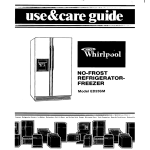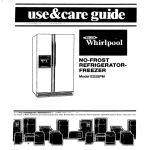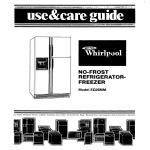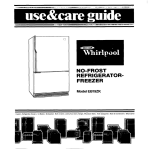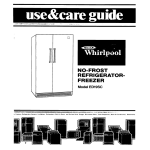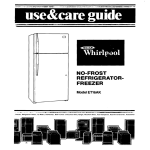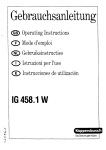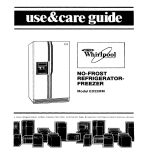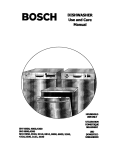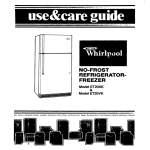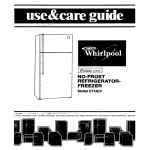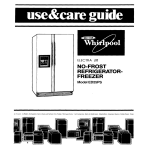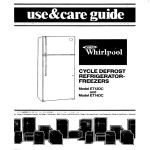Download REFRIGERATOR- FREEZER
Transcript
REFRIGERATORFREEZER 4 IS. Freezers. Reirlgetator.Freelers, III,, Ice Makers. DIshwashers _ BullbIn Ovens 1 and Surface Model Units. Ranges. ED25SM MIcrowave Ovens. Trash Compaclors. Room Air Condllloners Dehumldlfl Please read this Use and Care Guide before you do anything else.. . This booklet tells you how to start your refrigerator, clean it, move shelves and adjust controls. It even tells you what new sounds to expect from your refrigerator. Treat your new refrigerator with care. Use it only to do what home refrigerators are designed to do. Parts and features (behind ice bin) Meat Pan with Cold Control Slide-Out ode1 and Serial Number Label Copy your Model and Serial Numbers here., . When you need service cx call with a question, have this information ready: 1. Complete label located Model and Serial Numbers as shown). Model Number (from the Serial Number 2. Purchase date from sales slip Purchase Copy this information in these spaces. Keep this book, your warranty and sales slip together in a handy place. 2 Service Date Company and Telephone Number 1j Contents SAFETYFIRST ......................... YOU PLUG IT IN. ............... 1 BEFORE Install Properly ...................... ii4’ Pacte Paae -3 3 Level Refrigerator-Freezer ............ Remove Sales Labels ................ Clean It ............................ Plugltln.. .......................... USING YOUR REFRIGERATOR........... Setting the Controls .................. Changing the Control Settings ........ Power Saving Control ................ Adjusting Crisper Humidity Control .... Adjusting Meat Pan Temperature ...... Adjusting Refrigerator Shelves ........ Removing Freezer Shelves ............ Removing Freezer Basket ............ Removing the Crisper, Meat Pan and Covers ....................... “¶xmws?~~r*d~.,~~~*~#~,-&~I >-II- 4 4 4 Changing the Light Bulbs ............. Removing the Base Grille ............ Cold Water and Ice Dispenser ........ Sounds You May Hear. ............... Energy Saving Tips, .................. 4 CLEANING YOUR REFRIGERATOR ...... Cleaning 4 5 Chart ..................... FOOD STORAGE GUIDE. ............... 5 5 Storing Fresh Food ................... Freezing and Storing Frozen Foods .... 5 6 VACATION AND MOVING CARE ....... IF YOU NEED SERVICE OR ASSISTANCE. 6 6 6 6 I. 2. 3. 4. Before Calling for Assistance ....... If You Need Assistance ............ If You Need Service ............... If You Have a Problem ............. -7 7 8 10 10 11 11 12 12 13 16 17 17 18 18 18 f 7 %i. 01986 Whirlpool 111*,a : s*:tr...... Corporation Before you plug it in IMPORTANT Before using your refrigerator, you are personally responsible for making sure that it... l is installed and leveled on a floor that will hold the weight, and in an area suitable for its size and use. l is connected only to the right kind of outlet, with the right electrical supply and grounding. (Refer to your “Electrical Requirements and Grounding Instructions:‘) l is used only for jobs expected of home refrigerators. is not near an oven, radiator or other heat source. is properly maintained. is out of the weather. is used in an area where the room temperature will not fall below 55” F (13” C). is not used by those who may not understand how it should be used. is not loaded with food before it has time to get properly cold. Install properly.. . Remove sales labels.. . Remove the Consumer Buy Guide label, tape and any inside labels before using the refrigerator To remove any remaining glue: 1. Rub briskly with thumb to make a ball then remove. OR 2. Soak area with dishwashing detergent solution (1 teaspoon detergent in 1 quart warm water) before removing glue as described in step 1. DO NOT USE rubbing alcohol or flammable or toxic solvents, such as acetone, gasoline, carbon tetmchloride, etc. These can damage the material. NOTE: DO NOT REMOVE ANY PERMANENT INSTRUCTION LABELS INSIDE YOUR REFRIGERATOR. Do not remove the Tech Sheet fastened under the refrigerator at the front. -wmmm”m,“&.C~*IIR*I ,r*-L*.I :,*1*:*= * I. *+vI.?IyLW,I Clean it.. . Clean your refrigerator before using it. See cleaning instructions on pagell, 1. Allow % inch (1.25 cm) space on each side and at the top of the refrigerator for ease of installation, 2. If the refrigerator is to be against a wall, you might want to leave extra space so the door can be opened wider 3. The refrigerator back can be flush against the wall. m.wda I I .I-i ‘_ >. ‘< ,. Level refrigerator-freezer.. 3-prong grounding type wall receptacle, . Refrigerator Power Cord RECOMMENDED Right to Raise; Left to lower I. 2. 3. 4. 4 Remove base grille [see page 7 ). To raise front, turn each screw to the right. To lower front, turn each screw to the left. Check with level. GROUNDING METHOD A 115 Volt, 60 Hz., AC only 15 or 20 ampere fused and properly grounded electrical supply is required. It is recommended that a separate circuit serving only this appliance be provided. Do not use an extension cord. Use a receptacle which cannot be turned off with a switch or pull chain. See individual electrical requirements and grounding ature package. instruction sheet in your liter- Using your refrigerator Temperature Control \ Air Control Power Air Outlet Setting the controls.. . The Temperature Control is in the refrigerator and the Air Control is In the freezer section When the refrigerator is plugged in for the first time.. 54@21 l95 3 2. Set the AIR TROL to 3. 1, Set the TEMPERATURE CONTROL to 3 Saving Control Give the refrigerator pletely before adding time to cool down comfood. [This may take sev- eral hours ) These settings should be about right for normal household refrigerator usage. The controls will be set about rrght when juice IS as cold as you like and when ice IS firm. CON milk or cream Do not block the air outlet on the control panel. Blockrng It can slow the air movement needed to keep temperatures at the level you set Changing the control settings.. . If you need to adjust temperatures In the refrrgerator or freezer, use the settrngs lIsted in the chart below. 181 l Adjust the Temperature Control first Wait at least 24 hours between adjustments. Then adjust the Air Control, If needed. I RECOMMENDED If Refrrgerator Section Is TOO WARM Door opened often Large amount of food added Room temperature too warm Temperature Atr Control Control 4 3 If Freezer Section is TOO WARM Door opened often Large amount of food added Very cold room temperature (can’t cycle often enough) Temperature Air Control Control 3 4 Controls not set correctly for your conditrons Temperature Air Control Control 2, If ICE isn’t MADE FAST ENOUGH Heavy Ice usage Very cold room temperature [can’t cycle often enough) Temperature Air Control Control 3 4 If BOTH SECTIONS are TOO WARM Door opened often Large amount of food added Very warm or very cold room temperatures Temperature Arr Control Control 3 : QUESTIONS? (page l REASONS: CONDITION . ..call your COOL-LINE service assistance telephone number l If Refrigerator ’ Section is TOO COLD 3 21 OFF Power Saving Control.. . The Power Saving Control on the Control sole operates electnc heaters around the openrngs. These heaters help keep moisture forming on the outside of the refrigerator. SETTINGS: Condoor from @elm 1 Use the “OFF” setting when humidity IS low 2. Use the “0N”setting if moisture forms on the outside of the refrigerator. Adjusting Adjusting crisper Humidity Control.. . You can control the amount of humidity In the moisture-sealed crrsper The control can be adjusted to any setting between LO and HI. LO [open) lets moist air out of crisper for best storage of fruits and vegetables with skins. HI (closed) keeps moist air in the crisper for best storage of fresh leafy vegetables. Adjusting the refrigerator meat pan temperature.. . Cold air flows against the meat pan through an opening between the freezer and the refrrgerator. This helps keep the meat pan colder than the rest of the refrigerator Set the control to let more or less cold air through Use Control to Adjust Meat Pan Temperatures / shelves... Shelves can be adjusted to match the way you use your refrigerator. Glass shelves are strong enough to hold bottles, milk and other heave food Items To remove l Lift UP and door shelves: out To replace: l l Insert hooks into guides on both sides. Push down. To replace: 1. Guide the rear hooks Into the slots in the shelf supports. 2. Ilt up front of shelf until hooks drop into slot Lower front of shelf to level position Removing freezer shelves.. . 1 LII? front slightly. 2 Loft back off supports 3. Replace in reverse order. Lltt the Front Then the Back Removing the freezer basket.. . For proper air movement, In place when the refrigerator To remove l l l l l basket the basket: Slide out to the stop Lift the front to clear the stop. Slide out the rest of the way To replace l keep the freezer is operating. the basket: Place basket on the slides. Make sure the wire stops clear the front of the slides. Slide basket in. . 6 Removing the crispeq meat pan and covers... To remove the crisper and meat pan: 1. Slide crisper and meat pan straight out to 2. Lift the front. 3. Slide the rest of the way out. 4. Replace in reverse order To remove the covers: Covers are held in place by two pegs at the back and two notched tabs in front. 1. Press front tabs out of the way. 2. Lift cover front. 3. Lift back off the pegs. 4. Replace in reverse order l Snap Back Into Place. Changing the light bulbs.. . WARNING: Before removing a light shield for cleaning or for replaclng the bulb, either unplug refrigerator or dlsconnect electrlclty leadlng to refrigerator at the main power supply. Shock and InJury can occur If electrlclty remains connected. light bulbs behind refrigerator trol consoles: and freezer con- 1. Pull control knob straight off. 2. Pull bottom of control panel straight out. 3. Lift top of panel off supports. 4. Replace with a 40-watt appliance bulb. 5. Replace panel in reverse order. light bulb behind ice maker: 1. Remove the ice bin [see ice maker instructions page9 1, 2. Replace 3. Replace with a 40-watt appliance ice bin. Dispenser light: bulb. 1. Reach the bulb through the dispenser area 2. Replace with a heavy-duty IO-watt bulb. I Pull Off the Dial; Pull Out at the Bottom Removing the base grille... 1. Open the doors. 2. Pull grille outwards r Metal Clips -I II as shown. 3. Do not removeTech sheet faste sned behind @le. 1. Line up grille support tabs with metal clips 2. Push firmly to snap into place. 3. Close the doors. Cold Water and Ice Dispenser... FOR ICE: FOR CHILLEDWATER: Press a sturdy glass against the Press a sturdy glass against the ice dispenser bar. (Pressure and tumbling can break a fragile glass.) Remc we the glass to stop dispensing. The first few batches of ice from the ice maker may have a bad taste. Throw them away This from new plumbing and parts. water dispenser bar. (Pressure can break a fragile glass.) Remove the glass to stop dispensing. If the dispenser is not used regularly, dispense enough every week to freshen the supply Allow 2-3 hours for chilling. The small, heated tray beneath the dispenser is designed There is no drain in this tray. Do not pour water into It. Ice Is dlspemsed from the ice maker storage bin in the freezer. When the dispenser bar is pressed, a trapdoor opens in a chute between the dispenser and the ice bin. Ice is moved from the bin and falls through the chute. When the dispenser bar is released, a faint buzzing sound may be heard for a few seconds. to evaporate small spills. Chllled water comes from a tank behind the meat pan. It holds about 50 ounces (1.5 L). When the refrigerator is first hooked up, press the water dispenser with a glass or a jar until you have drawn and discarded 2 cr 3 quarts (1.9 to 2.8 L). Only air will came out to start with. The water you draw and discard will rinse the tank and pipes. Allow about 24 hours to chill the first tankful. Common Problems PROBLEM CAUSE SOLUTION Dlspenser won’t work. Freezer door open. l Ice dlrpenser work. Ice bin not properly installed. Wrong ice in ice bin. l Make sure bin is pushed all the way in. l Use only ice crescents from Ice maker. won’t Close the freezer door. Other shapes won’t dispense properly. Ice dlspenser worklng. stops Ott-taste or odor In Ice. Ice dispenser bar held in too long. l Ice attracts airborne Old ice. Water quality. l odors. Foods not properly wrapped. Ice bin and freezer may need cleaning. Plumbing to ice maker: New ice maker. 8 l l l l l l Wait about 3 minutes for the dispenser motor to reset. Large amounts of ice should be taken from the bin, not through the dispenser. Use rapidly or store in covered container: Dump old ice and make new supply Water containing minerals (such as sulfur] may require a filter to remove. Wrap properly See pages 13 and 14. Clean freezer and ice bin. See Cleaning Chart on page 11. Follow installation instructions for proper ice maker water supply hook-up. The first few loads of ice from a new ice maker may have an off-taste. Dump ice and make new supply. TIPS l The dispensers door closed. l The ice dispenser will work only if the bin is pushed all the way in. l will work only with the freezer Use only Ice crescents trom the Ice maker. Other shapes won’t dispense properly. l When you need more ice than a glass or two, scoop it from the bin or remove the bin. The dispenser motor may stop if the dispenser bar is held in too long. It will be ready to run again in about 3 minutes. l Ice stored too long can go stale., .like water. Throw it away. l Ice can shrink. Cold moving air slowly evaporates them. If you use ice often, you may never notice the change. l Good water quality is important for good ice quality. It is not recommended that the ice maker be connected to a softened water supply. Water softener chemicals such as salt from a malfunctioning softener can damage the ice maker mold and lead to poor quality ice. If a softened water supply cannot be avoided, then it is important that the water softener be well maintained and operating properly. Plan to remove and empty the storage bln: l l l If the ice dispenser has not, or will not be used fora week or more; If a power failure causes ice in the bin to melt and freeze together; If the ice dispenser is not used regularly. 1. Pull the covering slide it to the rear. . panel out from the bottom and 2. Lift the signal arm so it clicks into the OFF position. Ice can still be dispensed, but no more will be made. 3. Lift the front of the storage 4 Empty brn the brn. Use hot or warm Ice if necessary It out water The night light uses a heavy-duty to melt the should last about purchase another Never use anythlng sharp to break up Ice in the bin. This can damage the btn and dispenser mechanrsm. 5. Wash wrth mild detergent. Rinse well Do not use harsh or abrasive cleansers or solvents. 6. When replacrng the bin, make sure it IS pushed in all the way. Push the signal arm down to the ON position to restart Ice praductron. IO-watt bulb. It 10,000 hours. When It burns out, from your dealer. Sounds you may hear.. . ‘5 P 3 ’ ,c Possible Sounds: l l Clicking Sounds: The defrost also makes Running l Causes: You may or Snapping Ice Maker Sounds: -trickling water -thud (clatter of ice) l Probable Slight Hum, Soft Hiss: Water Sounds: l Your new refrtgerator may make sounds that your old one didn’t Because the sounds are new to you. you might be concerned about them. Don’t be Most of the new sounds are normal. Hard surfaces like the floor, walls and cabinets can make the sounds seem louder. The following chart describes the kinds of sounds that might be new to you, and what may be making them. Sounds: hear the refrtgerator’s fan motor and moving air. timer makes a definite clrck when the refrigerator a sound when the refrigerator starts. stops runnrng. When the refrtgerator stops running, you may hear gurgling in the tubing for a few minutes after it stops. You may also hear defrost water running into the defrost water pan tf your refrigerator has an Ice maker, valve], trickling water and the clatter you may hear of ice dumped buzzing (from Into the bin Your refrigerator has a high-efficiency compressor and motor. than older designs It may even seem to run most of the time. the water It will run longer Energy saving tips... You can help your refrigerator use less electricity Check door gaskets for a tight seal Level the cabinet to be sure of a good seal l Clean the condenser coil regularly l Open the door as few times as possible Think about what you need before You open the door. Get everything out at one time Keep foods organized SO You won’t have to search for what you want Close door as soon as food is removed l Go ahead and fill up the refrigerator, but don’t overcrowd it so air movement IS blocked l l 10 It l l It IS a waste of electrlclty to set the refrigerator and freezer to temperatures colder than they need to be If Ice cream IS firm In the freezer and drinks are as cold as your family likes them, that’s cold enough. Keep the Power Saving Control on OFF unless moisture forms on the refrigerator exterior Make sure your refrigerator is not next to a heat source such as a range, water heater, furnace. radiator, or in direct sunlight. Cleaning your refrigerator To clean your refrigerator, turn the Temperature Control to OFF, unplug it, take out all removable parts, and clean it according to the following directions. Both the refrigerator and freezer sections defrost automatically. But both should be cleaned about once a month to help prevent odors from buildina up. Of course, spills should be wiped up right away- Cleaning chart... Part What to use How to clean Removable parts [shelves, crisper, meal pan etc.) Sponge or cloth; mild detergent and warm water Outside Sponge, cloth or paper towel; mild detergent; appliance wax [or good auto paste wax]. l l l Wash removable parts with warm water and a mild detergent. Rinse and dry Wash with warm water and a mild detergent. Do not use abrasive or harsh cleansers. l l Rinse and dry Wax painted metal surfaces at least twice a year with appliance wax or a good auto paste wax. Apply wax with a clean, soft cloth. Do not use wax on piastfc parts. Waxing palnted Inside walls [Freezer should be allowed to warm up so cloth won’t stick.) metal surfaces provldes rust protection. Sponge, soft cloth or paper towel, baking soda, warm water, mild detergent. l l Door liners and gaskets Sponge, soft cloth or paper towel; mild detergent, warm water l l Wash with warm water and -mild detergent or ~ baking soda (2 tablespoons 1 quart [ .95 I] warm water Rinse and dry Wash with mild detergent water Rinse and dry. [26 g] to and warm DO NOT USE Cleaning waxes, concentrated detergents, bleaches or cleansers containing petroleum on plastic parts. Dark plastics (covers and panels) Mild detergent and warm water; soft, clean sponge and soft, clean cloth. l l Wash with a soft grit-free cloth or sponge. Rinse and dry with a damp grit-free cloth or chamois. DO NOT USE paper towels, window sprays, scouring cleansers, or flammable or toxic solvents ilke acetone, gasoline, carbon tetrachioride, etc. These can scratch or damage the material. Defrost pan Sponge or cloth; mild detergent and warm water Remove base grille. (See page 7 .) To remove defrost pan, lift pan over wire brace (remove tape; if any). Wash defrost pan with warm water and mild detergent. Rinse and dry Replace with notched corner to the rear, Push it all the way in. Make sure defrost drain tube is pointing into pan. Replace base grille. l l l l l l l l Condenser Coil Vacuum cleaner; using the extended narrow attachment, l l l Floor under refrigerator Usual floor cleaners. l l l l Remove base grille. Clean dust and lint from condenser least every other month. Replace base grille. at Roll refrigerator out only as far as water supply line allows. Wash floor. Roll refrigerator back. Check to see if the refrigerator is level. 11 Cured or Smoked Meat and Cold Cuts. Ham, bacon, sausage, cold cuts, etc., keep best in original wrappings. Once opened, tightly re-wrap in plastic wrap or aluminum foil. Canned Ham. State in refrigerator unless the label says it’s okay to store on the shelf. Do not freeze. Fresh Pouitry...Wrap in plastic wrap. The plastic wrap on poultry, as purchased, may be used for storage. There is a right way to package and store refrigerated or frozen foods. To keep foods fresher, longer, take the time to study these recommended steps. leafy Vegetables., VarietyMeats . . . . . . . . . . . . . . . . ,... Chlcken . . . . . . . . . . . , . . . . . . . . . . . . . . Ground beef . . . . . . . . . . . . . . . . . . . . . . SteaksandRoasts ................ cz%w&f:pqta ..................... . . . . . . ..*................... CofdCuts ................... ... .. 1 to2 1 to2 1 to 2 3 to5 ; k ;o Remove store wrapping and off bruised and discolored areas, Wash in 3toS and drain. Place in plastic bag or plastic ‘Itmedistobe!itoredlulg6rthonthetimes~. and store in crisper. Cold, moist air helps follow ftedmcnons for fwBZhQ. vegetables fresh and crisp. L Vegetables with Skins (carrots, peppers)...Store In crisper, plastic bags or plastic container. NOTE: Fresh fish and shellfish should be used the Frults . ..Wash. let dry and store in refrigerator in same day as purchased. plastic bags OT crisper. Do not wash or hull berries until they are ready to use. Sort and keep berries in their store container in a crisper, or store in a loosely closed paper bag on a refrigerator shelf. trim or iear :old water container deep leafy Meat* Meat is perishable and expensive...you won’t want to waste an ounce of it through careless handling. The following list and chart give you packaging hints and time limits. Store meat in the meat pan. Fresh, Prepackaged Meat. Store fresh meat in the store wrapping. Vacuum packaged meat can be frozen for as long as one month if the seal is not broken. If you want to keep it frozen longer, you should wrap it with special freezer wrapping material. Fresh Meat, Not Prepackaged. Remove the market wrapping paper and re-wrap in aluminum foil for storing it unfrozen. Cooked Meat. Wrap or cover cooked meat with plastic wrap or aluminum foil. Store immediately. Eggs .Store without washing in the original carton or use the Utility Bin that came with your refrigerator. Mlik...Wipe milk cartons. For best storage, place milk on interior shelf or bottom door shelf. Beverages...Wipe bottles and cans. Store on a door shelf or inside the refrigerator. Butter.. .Keep opened butter in covered dish or in the Utility Compartment. When storing an extra supply. wrap in freezer packaging and freeze. Cheese .Store in the original wrapping until you are ready to use it. Once opened, re-wrap ?ightly in plastic wrap or aluminum foil. Condiments .Store small jars and bottles (catsup, mustard, jelly, olives] on the door shelves where they are in easy reach. Leftoven...Cover leftovers with plastic wrap or aluminum foil to keep food from drying out and transferring food odors. Plastic containers with tight lids are fine, too. FREEZING & STORING FROZEN FOODS 3 The freezer section is designed for storage of commercially frozen foods and for freezing foods at home. Packaging - The secret of successful freezing is in the packaging. The wrap you use must be air, moisture and vapor proof. The way you close and seal the package must not allow air, moisture or vapor in or out. Packaging done in any other way could cause food odor and taste transfer throughout the refrigerator and drying of frozen food. Rigid polyethylene [plastic) containers with tightfitting lids, straight-sided canning/freezing jars, heavy-duty aluminum foil, plastic-ccated paper and non-permeable plastic wraps [such as Saran) are recommended. Note: Heat-sealed boiling bags are easy to use and can be used by themselves or as carton liners. Sealing - When sealing foods in bags squeeze out the air (liquids need headspace to allow for expansion.] Twist the top and turn it back. Fasten tie securely around the doubled-over tail. Put the label inside transparent bags; use self-adhesive label on outside of opaque ones. Air-tight wrapping calls for “drugstore” wrap. Cut the sheet about one-third longer than the distance around the food. Bring the ends together and fold in (toward the food] at least twice to seal out air. Crease ends close to food, press air from package. Fold tips 6 over twice. Finish package and tape closed. NOTI With unboned meats, pad sharp edges with extr wrap or use stockinette to protect the wrap fror punctures. DO NOT USE: Bread wrappers l Non-polyethylene plastic containers l Containers without tight lids l Waxed paper l Waxed-coated freezer wrap l Thin, semi-permeable wrap None of these are totally moisture, air or vapor proof. The use of these wmpplngs could l cause food odor and taste tmnsfer and drying of frozen food. Freezlng Fruits-Select ripe, blemish-free fruit Be sure they taste as good as they look. Wash 2 t 3 quarts (liters] at a time and drain. Fruit that stanc in water may lose food value and become, sags Sort, peel, trim, pit and slice as needed. Pack in rigid wide-mouthed containers or othc recommended material. Leave head space to c low liquids to expand during freezing. Freezing Vegetables - Freeze only fresh highquality vegetables picked when barely mature. For best results, freeze no more than 2 to 3 hours after picking. Wash in cold water, sort and cut into appropriate sizes. Blanch or scald. Pack in recommended container and freeze. Do not freeze lettuce, celery, carrot sticks, potatoes or fresh tomatoes. All will become limp or mushy. Tomatoes will collapse when thawed. Freezing Cooked Food -Prepare cooked foods as you would for the table; shorten cooking time10 tol5minutes toallowforadditional cooking during reheating. Omit seasonings and part of the liquid. Plan to add them at reheating time. Potatoes should also be added to soup and stew at heating time. Add crumb and cheese toppings at heating time. Cool as rapidly as possible and freeze at once. Liquid or semi-liquid dishes may be frozen in recommended containers with head-space. Casseroles and other more solid foods may be frozen in the baking container. If you don’t want to leave your casserole dish in the freezer, line it with foil. Bake, cool, freeze, lift out the foil package, bag it and return to freezer. :. * .i,!‘1:: il ‘1:: :‘1 Freezing Meats-The meat you thaw can only be as good as the meat you freeze. “Drugstore” wrap in meal-size packages. Flat cuts or patties should be wrapped individually or in layers separated by a double thickness of freezer wrap. Make sure store wrappings are moisture and vapor proof. If not, re-wrap meats with one of the wraps recommended under “Packaging”. Freezing Baked Goods - Wrap baked breads in recommended material. Thaw in wrapping. Unbaked yeast breads can be frozen after the first rising. Punch down, wrap and freeze. Bake cookies as usual. Cool and freeze on trays. then pack in recommended freezer bags or cartons. Unbaked cookies may be dropped, molded or rolled and frozen on cookie trays. Store in bag OT carton: bake without thawing. Refrigerator-type cookies can be wrapped and frozen in roll form. Thaw only enough to slice when ready to bake. Fruit pies are best frozen unbaked. Bake without thawing. Bake pecan and similar pies before freezing...rich fillings do not freeze solid. Cut steam vents in top crusts when ready to bake. I IMPORTANT: Do not expect your freezer to quick-freeze any large quantity of food. Put no more unfrozen food into the freezer than will freeze withln 24 hours. (No more than 2 to 3 pounds of fresh meat or 3 to 4 pounds of vegetables per cubic foot of freezer space.) leave enough space for air to circulate around packages. Be careful to leave enough room at the front so the door can close tightly. FOODSTORAGECHART Storage times* will vary according to the quality of the food, the type of packaging or wrap used (moisture and vapor-proof). and the storage temperature which should be 0” F ( -17.8”c). Food Storage tlme FRUITS Fruit juice concentrate . . . . . 12 months Commercially frozen fruit . . 12 months Cltrus fruit and juices.. . . 4 to 6 months Others . . . . . . . . . . . . . . . . . B to 12 months VEGETABLES Commercially frozen . . . . . . . 8 months Home frozen . . . . . . . . . . . 8 to 12 months MEAT Bacon . . . . . . . . . . . . . . . . 4 weeks or less Corned beef . . . . . . . . . . . . . . . . . 2 weeks Cured ham . . . . . . . . . . . . . 1 to 2 months (Salting meat shortens freezer life) Frankfurters . . . . . . . . . . . . . . . . . . 1 month Ground beef, iamb, veal 2 to 3 months Roasts: Beef . . . . . . . . . . . . . . . . . 6 to 12 months lamb and veal . . . . . . . 6 to 9 months Pork.. . . . . . . . . . . . . . . . . . 4 to8 months Sausage, fresh . . . . . . , . . . 1 to 2 months Steaks and chops: Beef . . . . . . . . . . . . . . , . . 8 to 12 months lamb, veal, pork . . . . . . 3 to4 months FISH Cod, flounder, haddock Sole....................... 6months Blue fish, salmon . . . . . . . . 2 to 3 months Mackerel, perch . . . . , . . . 2 to 3 months Breaded fish (purchased) . . . 3 months Clams, oysters, cooked fish. crab, scallops , . . . 3 to4 months Alaskan king crab . . . . . . . . . 10 months . . . . . . . . . 12 months Shrimp, uncooked POULTRY Whole chicken or turkey.. . . 12 months Duck . . . . . . . . . . . . . . . . . . . . . . . . 6months Giblets . . . . . . . . . . . . . . . . . . 2 to 3 months Cooked poultry w/gravy . . . 6 months Slices (no gravy) . . . . . . . . . . . . 1 month Food Storage time MAIN DISHES Stews; meat, poultry and fish casserole . . . . 2 to 3 months TV dinners. . . . . . . . . . . . . . . 3 to 6 months DAIRY PRODUCTS Butter . . . . . . . . . . . . . . . . . . 6 to 9 months Margarine . . . . . . . . . . . . . 2 to 9 months Cheese: Camembert, brick, Mozzarella, farmer’s . . . . 3 months Creamed cottage . . DO NOT FREEZE Cheddar, Edam, Gouda, Swiss, etc. . . . . . . . . . . . . 6 to 8 weeks , Freezlng can change texture of cheese. Ice cream, ice milk sherbet . . . . . . . . . . . . . . . . . . . 4 weeks EGGS Whole (mixed) . . . . . . . . . 9 to 12 months Whites . . . . . . . . . . . . , . . . . 9 to 12 months Yolks . . . . . . . . . . . . . . . . . . . 9 to 12 months (Add sugar or salt to yolks or whole mixed eggs) BAKED GOODS Yeast breads and roils . . . . . . 3 months Baked Brown ‘N Serve roils . . . . . . . . . . . . . . . . . . . . . . . 3 months Unbaked breads.. . . . . . . . . . . . 1 month Quick breads . . . . . . . . . . . 2 to 3 months Cakes, unfrosted . . . . . . ., 2 to 4 months Cakes, frosted . . . . . . . . . 8 to 12 months Fruit cakes . . . . . . . . . . . . . . . . . 12 months Cookie dough . . . . . . . . . . . . . . 3 months Baked cookies . . . . . . . . . 8 to 12 months Baked pies.. . . . . . . . . . . . . 1 to 2 months Pie dough only . . . . . . . . . . 4 to 6 months ‘Based on US DA and Mlchlgon suggested storage times If electricity Cooperailve Extensvzr Sarvlce goes off Call the power company. Ask how long power will be off 1. If servrce IS to be Interrupted 24 hours or less keep both doors closed Thts will help frozer fo&s to stay frozen. 2. If service is to be interrupted longer than 2z hours, (a] Remove all frozen food and store In c frozen food locker. Or. (b) Place 2 Ibs (0.9 kg) of dry ice in freezer fo every cu. ft. of freezer space. This WIII keep frozen foods for 2 to 4 days. Wear gloves tc protect your hands from dry ice burns. (c) If neither food locker storage nor dry ICE IS available, use or can perrshable foot 3. A fulaf%~~ will stay cold longer than a partI\ filled one. A freezer full of meat WIII stay COIC longer than a freezer full of baked goods I food contains Ice crystals, it may be safe11 refrozen, although the qualrty and flavor ma\ be affected. Use refrozen foods qurckly. If the conditron of the food IS poor or you have an! suspicions, it is wise to dispose of It. Vacation Short vacations. . . Moving. . . No need to shut off the refrigerator if you will be away for less than four weeks. Use up perishables; freeze other items. If your refrigerator is equipped with an automatic ice maker, 1) turn it off; 2) shut off the water supply to the ice maker; 3) empty the ice bin. If your refrigerator is equipped with an automatic ice maker, shut off the ice maker water supply a day ahead of time. Disconnect the water line. After the last supply of ice drops, lift the signal arm to turn off the ice maker Remove all food. Pack frozen foods in dry ice. Unplug the refrigerator and clean it thoroughly. Remove everything that comes out. Wrap all parts well and tape them together so they don’t shift and rattle. Also, remove the water supply tank behind the meat pan by: 1. Disconnecting water inlet and outjet tubes at the top of the tank. 2. Removing three mounting screws from the tank. 3. Draining the tank. Re-install the empty tank, and remember to check for tight water connections when the refrigerator is hooked up at your new location. Screw in the levelling rollers; tape the doors shut; tape the electric cord to the cabinet. When you get to your new home, put everything back, and refer to page 4. Don’t fcrget to reconnect the water supply line if you have an icemaker. Long vacations. . . Remove all the food if you are going for a month or more. If your refrigerator is equipped with an automatic ice maker, turn off the water supply to the ice maker at least a day ahead. When the last load of ice drops, turn off the ice maker. Unplug the refrigerator and clean it...rinse well and dry. Tape rubber or wood blocks to both doors ...keeping them open far enough for air to get in. This will keep odor and mold from building up. WARNING: Tape blocks out reach...do not allow the refrigerator when blocked open. They InJured or trapped. To restart refrigerator, 16 of a child’s children near the doors are may become see “Using Your Refrigerator.” QUESTIONS? ...call your COOL-LINE@’ service assistance telephone number (page 181. If you need service or assistance, we suggest you follow these four steps: 1, Before calling for assistance... Performance problems often result from little things you can find and fix yourself without tools of any kind. if your refrigerator l will not operate: if your ice maker will not operate: l l l Has the freezer had enough time to get cold? With a new refrigerator, this might take overnight. Is the signal arm ON...in the down position? Is the water valve turned on? Is water getting to the ice maker? Is the power supply cord plugged into a live circuit with the proper voltage? [See page 4.) if there is water in the defrost pan: l In hot, muggy weather, this is normal. The pan can even be half full. Make sure the refrigerator is level so the pan doesn’t overflow. if the lights are not working: Have you checked your home’s main fuses or circuit breaker box? Is the power supply cord plugged into a live circuit with the proper voltage? [See page 4.) l l l l Have you checked breaker box? Is the Temperature your home’s main fuses or circuit Control turned ON? if there is a rattiing or jingling familiar sounds: l l if a-bulb is burned out: l noise, or other un- Is something on top or behind the refrigerator making noise when the refrigerator is running? New features on your new refrigerator make new sounds. You may be hearing air flowing from the fans, timer clicks for the defrosting cycle, defrost water draining into the defrost pan. See instructions for changing Use appliance bulbs only, light bulbs on page 7. if the motor seems to run too much: Is the condenser, behind the base grille, free of dust and lint? l On hot days, or if the room is warm, the motor naturally runs longer l If the door has been opened a lot, or if a large amount of food has been put in, the motor will run longer to cool down the interior, Remember: Motor running time depends on different things number of door openings, amount of food stored, temperature of the room, setting of the controls, And, your new refrigerator may be larger than your old one so it has more space to be cooled. It also has a regular freezer instead of a frozen food compartment. All this means better refrigeration and may require more running time than your old one. l 2. If you need assistance*... 4. If you have a problem*... Call our COOL-LINE service assistance telephone number (see Step 2) and talk with one of our Consultants, or if you prefer, write to: Call Whirlpool COOL-LINE@ service assistance telephone number. Dial free from: Continental U.S. . . . . . . . . . . . . . (800) 253-1301 Michigan . . . . . . . . . . . . . . . . . . . . (800) 632-2243 Alaska & Hawaii . . . . . . . . . . . . (800) 253-1121 and talk with one of our trained sultant can instruct you in how operation from your appliance sary, recommend a qualified your area. 3. Consultants. The Conto obtain satisfactory or, if service is necesservice company in If you need setice*... Whirlpool has a nationwide network of franchised TECH-CARE @ Service Companies. TECH-CARE service technicians are trained to fulfill the product warranty and provide after-warranty service, I FRANCHISED SERVICE anywhere in the United States. To locate TECHCARE service in your area, call our COOL-LINE service assistance telephone number [see Step 2) or look in your telephone directory Yellow Pages under: ELECTRICAL MAJOR- APPLIANCES-HOUSEHOLDMAJOR-SERVICE&REPAIR OR APPLIANCESREPAIRING 6 PARTS WHIRLPOOL APPLIANCES FRANCHISE0 TECH.CARE SERVICE WHIRLPOOL APPLIANCES FRANCHISED TECH-CARE SERVICE SERVICE XYZ SERVICE CO 123 Maple . . . . SERVICE XYZ SERVICE CO 123 Maple. COMPA NILS 999.9999 OR WASHING MACHINES. 6 IRONERS-SERVICING 18 DRYERS WHIRLPOOL APPLIANCES FRANCHISED TECH-CARE SERVICE SERVICE XYZ SERVICE CO 123 Maple 999-9999 COMPANIES COMPANIES . . 999.9999 Mr. Robert Stanley Division Vice President Whirlpool Corporation 2000 US-33, North Benton Harbor, MI 49022 *If you must call or write, please provide: model number, serial number, date of purchase, and a complete description of the problem. This information is needed in order to better respond to your request for assistance. 0 FSP @ FSP is a registered trademark of Whirlpool Corporotlon for quality parts. Look for this symbol of quality whenever you need a replacement part for your Whirlpool appliance. FSP replacement ports will fit right and work right, because they ore made to the same exacting speciflcatlons used to build every new WhIrlpool appllonce Notes n :i Making No. 1109122 01986 Whirlpool your world a little easier. Printed in U.S.A. Corporation _LM.*adr,Yli.:~.f4~~, 1; *li:.z;.:.. ,I ..i z, -2. : ir I / r.k,,v,J: :. ; ‘. l> j ! Makers. Dishwashers, Bwll-In Ovens and Surface Units. Ranges. Microwave Ovens. Trash Compactors. Room Air Condilloners. Oehumidlfiers. Automatic Washers, Clothes Orye




















